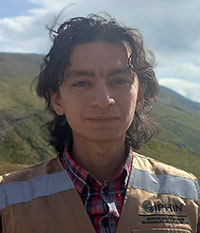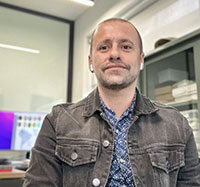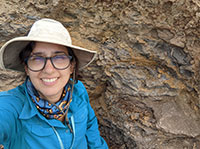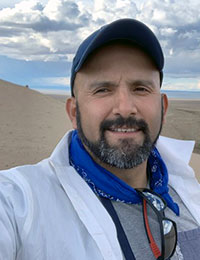 Héctor D. Palma-Castro. Departamento de Biología and Grupo de investigación en Paleobiología e Historia Natural, Universidad Nacional de Colombia, Carrera 30 No. 45-03 Bogotá, Colombia and Museo Paleontológico de Villa de Leyva, Universidad Nacional de Colombia, Km 1.5 Vía Arcabuco Villa de Leyva, Colombia. Corresponding author. hdpalmac@unal.edu.co
Héctor D. Palma-Castro. Departamento de Biología and Grupo de investigación en Paleobiología e Historia Natural, Universidad Nacional de Colombia, Carrera 30 No. 45-03 Bogotá, Colombia and Museo Paleontológico de Villa de Leyva, Universidad Nacional de Colombia, Km 1.5 Vía Arcabuco Villa de Leyva, Colombia. Corresponding author. hdpalmac@unal.edu.co
Héctor Palma-Castro obtained his bachelor's in geology from the Universidad Nacional de Colombia in 2020 and started his master's studies in Biology at the same university in 2021. He has worked for the Paleontological Museum of Villa de Leyva from the Universidad Nacional de Colombia. His research focused on Lower Cretaceous flora from Colombia, mainly conifers and other gymnosperms. He aims to understand the diversity and changes in lower latitude floras from the Lower Cretaceous.
![]()
 Diego A. Cómbita-Romero. Departamento de Geociencias and Grupo de investigación en Paleobiología e Historia Natural, Universidad Nacional de Colombia, Carrera 30 No. 45-03 Bogotá, Colombia and Museo Paleontológico de Villa de Leyva, Universidad Nacional de Colombia, Km 1.5 Vía Arcabuco Villa de Leyva, Colombia. dacombitar@unal.edu.co
Diego A. Cómbita-Romero. Departamento de Geociencias and Grupo de investigación en Paleobiología e Historia Natural, Universidad Nacional de Colombia, Carrera 30 No. 45-03 Bogotá, Colombia and Museo Paleontológico de Villa de Leyva, Universidad Nacional de Colombia, Km 1.5 Vía Arcabuco Villa de Leyva, Colombia. dacombitar@unal.edu.co
Diego Cómbita received his bachelor's (B.S.) in geology from the Universidad Nacional de Colombia. With extracurricular experience in fossil preparation, paleontological collections management, scientific outreach, 3D modeling, and printing. Currently, he is working at the Museo Paleontologico de Villa de Leyva, Boyacá, Colombia. His research has focused on marine sea turtle fossils from Colombia and Panamá. He aims to understand the paleoecological role of fossil marine turtles and how it changed from the early Cretaceous till today.
![]()
 Edwin-Alberto Cadena. Facultad de Ciencias Naturales and Grupo de Investigación Paleontología Neotropical Tradicional y Molecular (PaleoNeo), Universidad del Rosario, Bogotá, 111221, Colombia and Smithsonian Tropical Research Institute, Box 0843-03092, Balboa, Ancon, Panama, Republic of Panama and Field Museum of Natural History, Chicago, Illinois, 60605, U.S.A. edwin.cadena@urosario.edu.co
Edwin-Alberto Cadena. Facultad de Ciencias Naturales and Grupo de Investigación Paleontología Neotropical Tradicional y Molecular (PaleoNeo), Universidad del Rosario, Bogotá, 111221, Colombia and Smithsonian Tropical Research Institute, Box 0843-03092, Balboa, Ancon, Panama, Republic of Panama and Field Museum of Natural History, Chicago, Illinois, 60605, U.S.A. edwin.cadena@urosario.edu.co
Dr. Cadena is a geologist from the Universidad Industrial de Santander, with a M.Sc. from the University of Florida and a Ph.D. in paleontology from North Carolina State University. He is a former postdoctoral fellow of the Alexander von Humboldt Foundation and the Senckenberg Museum in Germany. He is currently director of graduate studies at the Faculty of Natural Sciences of the Universidad del Rosario and research associate at the Smithsonian Tropical Research Institute and the Field Museum of Chicago. His research experience is mainly focused on the evolution of neotropical turtles and molecular paleontology.
![]()
 Mónica R. Carvalho. Museum of Paleontology and Department of Earth and Environmental Sciences, University of Michigan, Ann Arbor, Michigan 48109, USA. marvalho@umich.edu
Mónica R. Carvalho. Museum of Paleontology and Department of Earth and Environmental Sciences, University of Michigan, Ann Arbor, Michigan 48109, USA. marvalho@umich.edu
Mónica Carvalho is an Assistant Curator at the Museum of Paleontology and Assistant Professor at the Department of Earth and Environmental Sciences at the University of Michigan. She received a Ph.D. in Integrative Plant Sciences from Cornell University in 2017 and a MS in Geosciences from the Pennsylvania State University in 2011.
Her research aims to understand how plants and tropical ecosystems have changed through geologic time. Mónica collects and studies plant fossils in tropical South America, and uses observational and experimental approaches to better understand the paleobiology and evolution of tropical rainforests. Her work documents how interactions between plants and insect herbivores are recorded in leaf damage, form-function relations of leaves, and how acclimation responses of tropical plants to climate change can inform ecosystem function in deep time.
![]()
 Fabiany Herrera. Earth Sciences, Negaunee Integrative Research Center, Field Museum of Natural History, Chicago, Illinois 60605, USA. fherrera@fieldmuseum.org
Fabiany Herrera. Earth Sciences, Negaunee Integrative Research Center, Field Museum of Natural History, Chicago, Illinois 60605, USA. fherrera@fieldmuseum.org
Fabiany Herrera is an Assistant Curator of Paleobotany at the Field Museum, Chicago. He received a Ph.D. in Biology from University of Florida & Florida Museum of Natural History in 2014 and a M.Sc. in Geology from University of Florida & Florida Museum of Natural History in 2008.
He grew up in Colombia, surrounded by the Andes and its many types of forests; from montane to rainforests. He first became interested in rocks and mountains during his high school years and quickly felt in love with fossil and living plants later as an undergraduate student.
Some of Fabiany's work includes the earliest evidence of Neotropical rainforests in South America (~60 million years old), enigmatic plants from the Mazon Creek Lagerstätte, Mongolia and China (~310-125 million years old), and fossil floras from Central America (~35-20 million years old).

